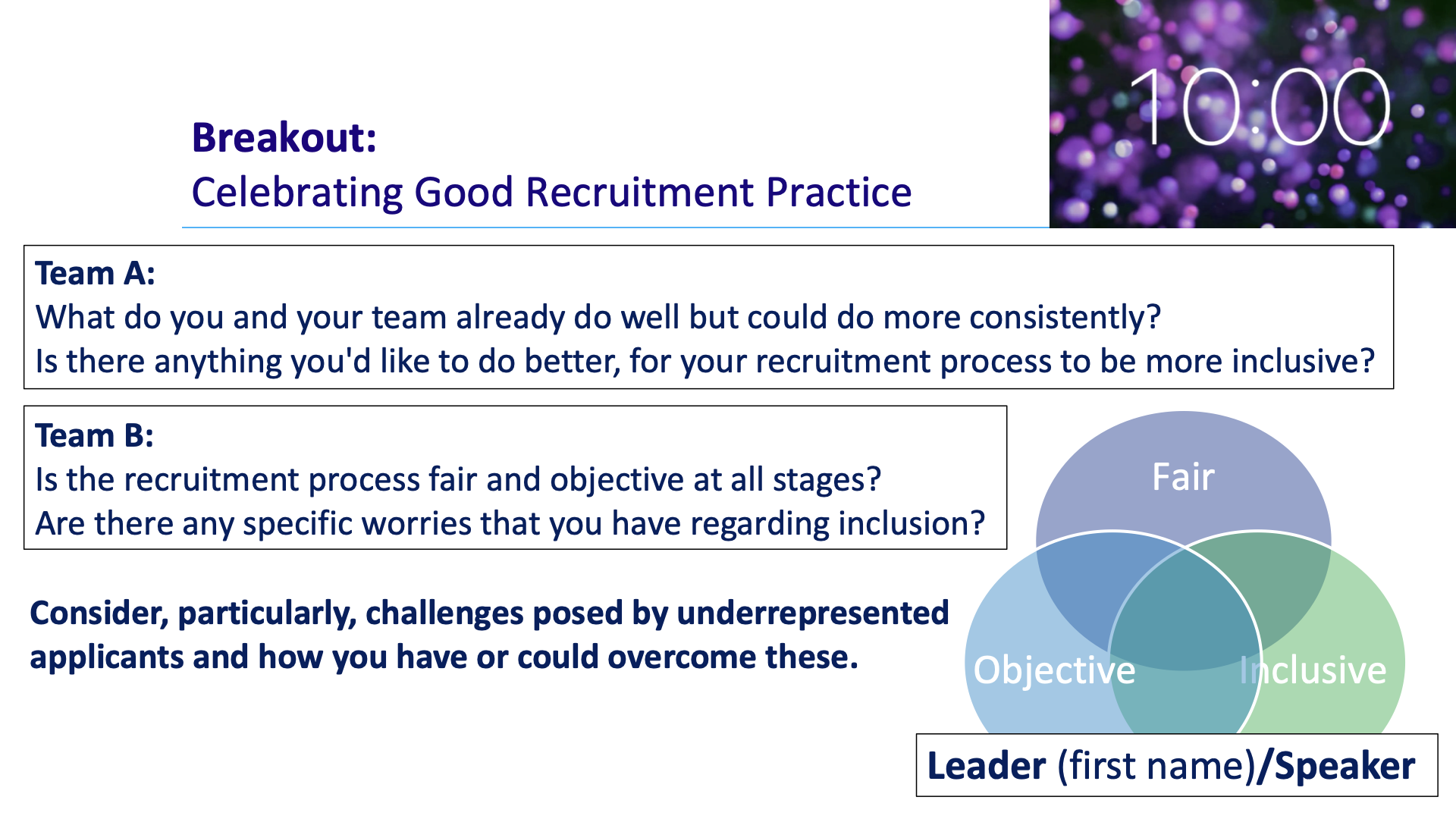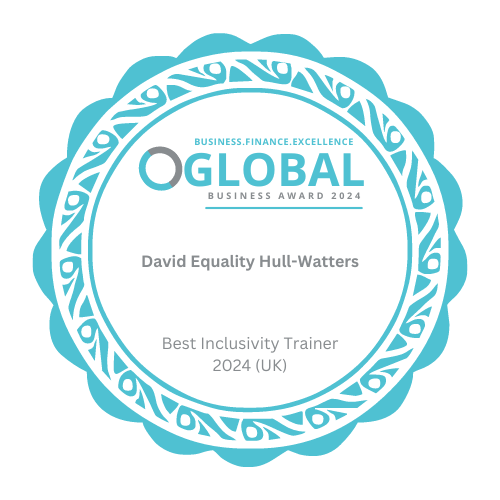Embedding Conscious Inclusion in
Talent Attraction and Recruitment Activities
- All breakout activities for today can be found on this page.
- Please keep the tab open for ease.
- Scroll to each new activity when the time comes.
- Please make sure that all voices are heard and select a speaker to share a summary of what has been discussed.
Breakout Activity One: Recruitment Procedure Audit
- The person whose first name comes first alphabetically will be the facilitator
- The facilitator will decide on a speaker who will feedback to the whole group, when we return to the Main Room. There is no pressure to be the speaker, so please choose another colleague, if you prefer not to take on this role.
- Please make sure that all voices are heard
Our objectives in this part of the session are:
Define the concepts of fairness and objectivity and consider any barriers to fair and objective recruitment.
Assess the strengths and areas for improvement of current procedures

Breakout Activity Two: Job Descriptions Best Practice
- The person born in the earliest month of the year will be the facilitator
- The facilitator will decide on a speaker who will feedback to the whole group, when we return to the Main Room. There is no pressure to be the speaker, so please choose another colleague, if you prefer not to take on this role.
- Please make sure that all voices are heard
Reflect upon current Job Descriptions/Adverts - strengths and areas for improvement.
Consider what makes an inclusive Job Description:
Do we really need X/Y/Z for the success of this role?
Are the competencies detailed more task orientated than people orientated?
Don’t include a criteria when it is not required, such as unnecessary qualifications
On reading the job description do you have images of a person you know?
Pay attention to the language used: consider if it is invoking stereotyping
Review the language for overt bias: Look for words such as energetic or dynamic which might be substituted for young
Is there an emphasis on vague words that are hard to define or understand?
Marketing materials should include positive role images, but more importantly highlight your commitment to diversity
Do you mention accessibility and workplace adjustments?
Poorly Written Job Descriptions and Advertisements:
1.Have Long Job Titles
2.Try to Have Clever Job Titles
3.Start with “About Us”
4.Are Written like Legalese
5.Are Written in the “3rd Person”
6.Have No Questions
7.Are Gender-Biased
8.Show Other Bias (Race, Age, Disability)
9.Use “Complex Words”
10.Fail to Have a Benefits Section
11.Fail to Mention Salary
12. Are Inconsistent

Breakout Activity Three: Common Biases that can be present in Job Interviews

Your first answer is A6. First Impression Bias - related to how a candidate presents themselves and behaves in the first few minutes of an interview. It’s one of the primary reasons behind bad hiring decisions. When you initially like someone, you tend to ask easier questions and look for things that confirm your positive impression.
B. It’s natural to feel more at ease with someone who shares similarities with you. These differences exist in how we express our emotions, too. According to a 2019 study by Lucy Zhang Bencharit., the way candidates share their excitement has a profound impact on hiring managers’ decisions. Candidates who shared a similar background with the recruiters—and expressed emotions similarly to them—were hired more often.
C. related to how you perceive candidates’ body language, the way they dress, and diverse non-verbal cues. These can include their ability to maintain eye contact, the strength of their handshake, or their posture, among others. For example, you might feel that a weak handshake is a red flag, but in fact, it doesn’t relate to candidates’ knowledge and experience.
D. the assumption that someone will perform in a specific way in a job because they belong to a given group. These can be related to the candidate’s nationality, ethnicity, gender, age, among other characteristics. For example, you could assume that a 50-year-old system administrator is not knowledgeable of the latest trends, but their age has, in fact, nothing to do with their skills.
E. when you believe that what the candidate did once would be what they always do in a similar situation. For example, if they were nervous during the interview, you might assume they’re always nervous.
F. remembering your last candidates better, while not clearly recalling the first interviews you did for a given position. This could mean that the last person you see might feel like a better fit for the job—simply because you remember them better. Take detailed notes and review them often to not fall prey to this bias.
G. related to the perceived attractiveness of candidates is most often unconscious—but might be particularly strong.
H. means that you’re prone to comparing the last candidate to the one you interviewed before that. You anchor their performance and your expectations to the performance of another interviewee, which means that your judgment is not neutral. If the previous candidate did poorly, the next one might seem a much better fit—even if they’re not actually qualified for the role.
I. We hear all the time that we should trust our instincts. In the context of hiring, however, this is actually an expression of unconscious bias and shouldn’t be the reason that motivates your hiring choices.

Breakout Activity Four: The Interviewing Process
Individually, you have written a values-based interview question (either general or tailored to a specific role). e.g. Which one of our values resonates with you the most and why? Being inclusive is one of our values – talk us through how you have adopted an inclusive approach when engaging with stakeholders?
To select your interviewee, find out who has been with the organisation the longest.
They will then answer your questions, whilst being aware of language, behaviours (including micro-behaviours) of the panel.
Panel, please also consider the positive micro-interactions (facial expression, verbal tone, use of encouraging language) of your fellow interviewers.
Expand practice by adding supplementary questions to draw more information from the interviewee.
For each question give a score based on the answer provided:
0 = no evidence, 1 = weak evidence, 2 = acceptable, 3 = good evidence 4 = excellent evidence.

















